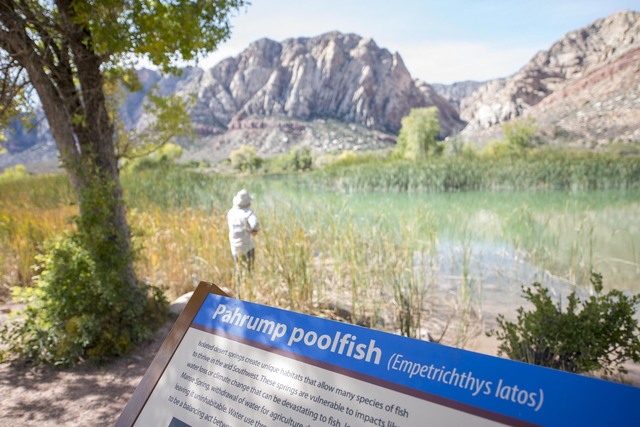
A rare desert fish once saved from extinction by a biologist with a bucket is in need of rescue once again, this time from non-native predators dumped into its home by people.
Biologists began trapping and removing Pahrump poolfish from a pond at Spring Mountain Ranch State Park in the last several weeks in a last-ditch effort to save a population that topped 10,000 in 2015 before crayfish and mosquito fish invaded their refuge.
During this year’s count, conducted in September, wildlife officials found just 362 of the endangered fish in the pond known as Lake Harriet, prompting the emergency relocation effort.
Brandon Senger, the supervisory fisheries biologist for the Nevada Department of Wildlife, called it a salvage operation.
If they’d waited just a few months more, he said, “this population easily could have blinked out of existence.”
The 155 poolfish rescued so far are now being kept in a 700-gallon tank at the state-run Lake Mead Fish Hatchery.
Senger said they could be stuck there for a year or more, as wildlife officials drain Lake Harriet dry and leave it that way for several months at least to kill off the predators. Poolfish embed.
Crayfish can be particularly hard to get rid of. “The damn things can live underground for a long time,” he said.
The crayfish feed on the adult poolfish and their eggs while the mosquito fish eat the newly hatched larvae. “It’s kind of a double whammy,” Senger said.
Wildlife officials believe the invaders were most likely introduced to the pond by someone who was cleaning out an aquarium or backyard water feature. Though the practice is illegal, the dumping of aquarium fish and other non-native creatures is “one of the biggest problems we have with a lot of our spring systems,” Senger said.
Lake Harriet is no exception. “We also found koi and a couple of turtles in there,” he said.
Once the pond is pest free, it will be refilled and restocked with poolfish.
No cost estimate for the work was immediately available, but department spokesman Doug Nielsen said it will likely be minimal.
For decades, the spring-fed pond 25 miles west of Las Vegas has served as one of only three safe havens left for the federally protected poolfish, which saw its native habitat wiped out in the 1970s when Manse Spring in Pahrump was pumped dry.
The fish joined the endangered species list in 1967. Four years later, the late UNLV biologist and desert fish expert Jim Deacon reportedly carried the last native members of the species out of Pahrump in a bucket to keep them from disappearing forever.
Senger said a few thousand Pahrump poolfish can still be found in Corn Creek at Desert National Wildlife Refuge, 30 miles northwest of Las Vegas, and in the Shoshone Ponds near Ely in White Pine County, about 250 miles northeast of Las Vegas.
The Las Vegas Valley Water District also is working with state and federal wildlife officials to establish a new poolfish refuge at the Springs Preserve, the district-owned attraction at U.S. Highway 95 and Valley View Boulevard.
Senger said it’s difficult to know how the species might be impacted by its recent brush with oblivion at Lake Harriet, but he likes its chances for recovery.
“The poolfish have had some bad luck, but they’re still around,” he said. “It kind of speaks to the resilience of these fish.”
Contact Henry Brean at hbrean@reviewjournal.com. Follow @RefriedBrean on Twitter.